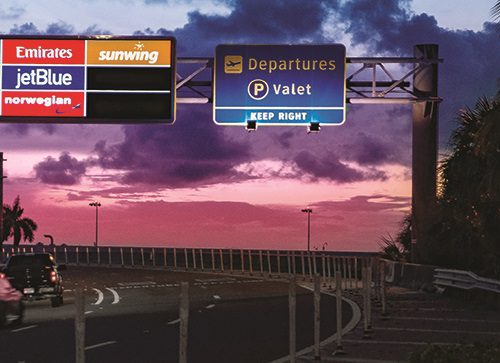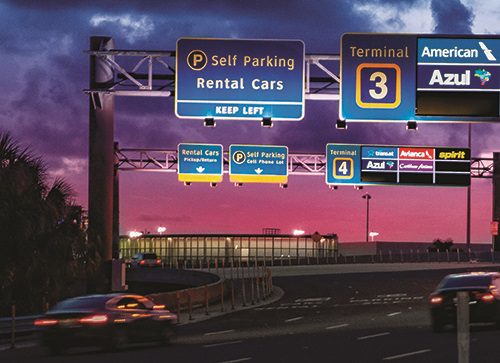New signage is making it easier for drivers to navigate Broward County’s Fort Lauderdale-Hollywood International (FLL). A comprehensive project substantially completed in December replaced aging signs with brighter, easier-to-read LED displays.
New signage is making it easier for drivers to navigate Broward County’s Fort Lauderdale-Hollywood International (FLL). A comprehensive project substantially completed in December replaced aging signs with brighter, easier-to-read LED displays. The new digital units allow the Florida airport to update messages and instructions for drivers in a matter of minutes. Estimated cost for the project is $15.3 million.
 “The addition of these modern and vibrant navigational signs is another example of how FLL is working to elevate the airport guest experience from arrival to departure,” says Mark Gale, chief executive officer/director of Aviation for the Broward County Aviation Department.
“The addition of these modern and vibrant navigational signs is another example of how FLL is working to elevate the airport guest experience from arrival to departure,” says Mark Gale, chief executive officer/director of Aviation for the Broward County Aviation Department.
In total, the airport installed nearly 5,400 new signs. Details such as colors, fonts and formatting were prescribed by a Signage and Wayfinding Master Plan that was completed in 2014. “We spent a lot of time developing these standards,” explains Staci Montefusco, expansion project administrator at the Broward County Aviation Department. “It was important that a passenger finding his or her way to FLL had an easy time navigating, that they didn’t have information overload, and that we had a clear and concise messaging hierarchy.”
|
Project: New Exterior Landside Signage
Location: Operated by: Broward County Aviation Dept. Est. Cost: $15.3 million
Funding: Scope: 5,390 signs (4,800 in parking garages; 550 curbside; 39 on entry road)
Installation:
Wayfinding/Architecture/Engineering: Digital Displays: Daktronics
Technology Consultant: General Contractor: Horsepower Electric Inc. Subcontractor: AUM Construction Inc.
Electrical Consultant: Static Signage: L&H Sign Co.
Roadway Static Panels:
Roadway Sensors: |
Most installations occurred from September 2019 to December 2020, however final completion of the overall wayfinding signage project is expected in September with the addition of more than 300 interior and exterior signs in the Rental Car Center.
While the latest phase of the project focused exclusively on roadways, curbsides and parking garages, signage inside the terminals is also being updated in stages. That work is part of a larger modernization initiative that began in 2016 with Terminals 1 and 4; Terminals 2 and 3 are slated for completion by fourth-quarter 2021.
A Logo is Worth a Thousand Words
Improved over-roadway signage is one of the most visible elements of the recent project. As drivers approach the airport, a series of five dynamic 10-by-32-foot LED signs provide airline information for each of FLL’s four terminals.
The former static signs, which listed carriers on colored backgrounds coded to the four terminals (yellow for T1, red for T2, purple for T3 and green for T4) had become dull and weathered, making them difficult to read. The electronic signs include full-color airline logos. “Motorists can recognize an airline logo easier than reading the airline name when trying to determine which terminal they should go to,” explains Montefusco.
David Park, senior experiential and wayfinding designer at Gresham Smith, notes that logos help motorists process the rapid succession of information they are presented with when entering the airport. “A driver doesn’t have a lot of time between signs to process all the information,” Park says. “Since the No. 1 question for anybody coming into the airport is ‘Where’s my airline?’ using logos makes those decisions easier as motorists quickly scan the signage.”
 Digital signs provide more than just enhanced graphics, adds LeAnn Holler, sales manager for the Southeast U.S. Region of Daktronics’ Transportation Group, which provided 81 LED displays for the project. “The airport wanted to use more logos and directional graphics and have more color in the background,” says Holler. “You can’t always achieve that with a static sign. But they also wanted the signage to be changeable and digital and, more importantly, dynamic. That really was the goal.”
Digital signs provide more than just enhanced graphics, adds LeAnn Holler, sales manager for the Southeast U.S. Region of Daktronics’ Transportation Group, which provided 81 LED displays for the project. “The airport wanted to use more logos and directional graphics and have more color in the background,” says Holler. “You can’t always achieve that with a static sign. But they also wanted the signage to be changeable and digital and, more importantly, dynamic. That really was the goal.”
Edward Hart, vice president and special systems discipline lead at Arora Engineers, notes that pixel pitch (the space between individual pixels) was an important factor. Taking into account average viewing distance, sign content and motorists’ average speed, a team from Arora and Daktronics determined that a 15.85 mm pixel pitch would provide the clearest viewing for over-roadway terminal signs. Smaller digital signs located closer to the terminal have a 10 mm pixel pitch. Curbside signs have an even tighter pixel pitch of 8 mm because curbside LED displays are viewed from closer distances.
 Color was important, too. The airline logos on FLL’s new digital signs have colored backgrounds that match the airlines’ logos corporate colors, per Daktronics’ recommendation. Clint Barber, project manager for the company’s Southeast U.S. Region, explains that white backgrounds, common for printed graphics, increase the intensity level of digital signs and cost more to operate because they draw more power.
Color was important, too. The airline logos on FLL’s new digital signs have colored backgrounds that match the airlines’ logos corporate colors, per Daktronics’ recommendation. Clint Barber, project manager for the company’s Southeast U.S. Region, explains that white backgrounds, common for printed graphics, increase the intensity level of digital signs and cost more to operate because they draw more power.
“We wanted to reinforce the same messaging that’s on the roadway, so when motorists approach the curbside, the dynamic sign also has the airline logo,” says Montefusco.
In total, the airport has 39 new road signs. Three are electronic, and five (the large overhead signs) are dynamic.

LED Boards for Breaking News
In addition to new signs, the airport installed two LED messaging boards above the main entry road. Airport personnel program the 15-by-11-foot boards to provide drivers with up-to-date information about issues of widespread importance such as traffic delays, weather alerts and, since the advent of COVID-19, face-covering requirements.
The airport recently used the messaging boards to inform and re-direct motorists when one of its terminals was temporarily closed overnight for emergency power infrastructure upgrades. “We avoided having to set up temporary curbside or roadway signage,” says FLL’s Montefusco.
 More typically, staff use the digital message boards to warn drivers about traffic congestion before they are stuck in the middle of it. Bluetooth sensors installed on the roadway by Horsepower Electric provide operations personnel with traffic data. When congestion is detected, personnel program the message boards to alert drivers about impending backups and suggest an alternate route. This allows drivers who are picking up passengers to arrange a new meeting spot. “The boards can tell motorists that if they use the suggested route, they will get through the airport traffic faster because, for instance, one level may have a 30-minute delay while the other level has no traffic issues,” Hart explains.
More typically, staff use the digital message boards to warn drivers about traffic congestion before they are stuck in the middle of it. Bluetooth sensors installed on the roadway by Horsepower Electric provide operations personnel with traffic data. When congestion is detected, personnel program the message boards to alert drivers about impending backups and suggest an alternate route. This allows drivers who are picking up passengers to arrange a new meeting spot. “The boards can tell motorists that if they use the suggested route, they will get through the airport traffic faster because, for instance, one level may have a 30-minute delay while the other level has no traffic issues,” Hart explains.
Montefusco notes that the new message boards allow FLL to address evolving conditions much more quickly. When a change was needed with the old system, personnel had to create a work order, and crewmembers would physically alter the signs from a bucket truck.
“Now, all of that work can be done in a minute or two, and does not require anyone actually going out on the roadway and disrupting traffic to change a sign,” she says. “It gives us enormous flexibility.”
Supporting Elements
 Engineers had to route electrical power to many of the dynamic signs and some of the new static signs. Benjamin Goebel, of Gresham Smith, explains that this process was time-consuming, but relatively uncomplicated, because most of the sources came directly from the terminals or power points along the roadway. Routing data communication lines to each of the new LED signs, however, was more challenging. The project team opted against transmitting information to signs wirelessly because of the potential for hacking and because of the propensity for severe weather in the area. Storms in southern Florida can wreak havoc with wireless communications, Hart and Goebel note. “It all had to be hardwired,” says Goebel. “And in some cases, we had to route all the way back to some of the main terminal buildings and then out thousands of feet to the new digital and dynamic signage.”
Engineers had to route electrical power to many of the dynamic signs and some of the new static signs. Benjamin Goebel, of Gresham Smith, explains that this process was time-consuming, but relatively uncomplicated, because most of the sources came directly from the terminals or power points along the roadway. Routing data communication lines to each of the new LED signs, however, was more challenging. The project team opted against transmitting information to signs wirelessly because of the potential for hacking and because of the propensity for severe weather in the area. Storms in southern Florida can wreak havoc with wireless communications, Hart and Goebel note. “It all had to be hardwired,” says Goebel. “And in some cases, we had to route all the way back to some of the main terminal buildings and then out thousands of feet to the new digital and dynamic signage.”
Although the improved over-roadway signs are about the same size as their predecessors, the new digital units are heavier than the old static signs. As such, engineers had to make significant structural modifications to the existing supports to prevent the need for FLL to spend millions of dollars on new structures. “Any time you have a design solution that can save money, that’s great,” remarks Park.
Better Wayfinding in Garages
One of the most challenging aspects of the project was updating signage in the airport’s three parking garages. In total, crews installed more than 4,800 signs (all static)—far more volume than in other areas.

New signage, some illuminated, provides guests with additional guidance to elevators and terminals. A new, more linear numbering system for rows helps them find their vehicles when they return. Renumbering the rows required a careful approach. “Replacing signage took three months, so we had to add temporary signs in all three garages that explained the changes,” says Montefusco.
Park notes that the project team took extra care to inform visitors about future changes—for instance, warning passengers that their parking spots might be renumbered when they returned after their trips.
Wayfinding keys that outlined specific changes were displayed throughout the garages, on exit doors and in baggage claim areas to keep passengers updated. Informational signage was posted two weeks before work began, and it remained up for two weeks after each floor was finished.
The airport also repainted the parking structure interiors. “Each floor is a different color,” explains Montefusco. “If a passenger doesn’t remember where they parked, they might remember the color of the floor they are on along with the quadrant of the parking garage.”
Beyond temporary signage, FLL used social media and its website to forewarn and alert the public about changes in its parking garages; but some guests still had trouble finding their vehicles. When that happened, airport and parking personnel often used the garages’ license plate recognition system to help them.
Widespread Enhancements
Reflecting on the project, Park from Gresham Smith details several improvements at FLL: It’s easier for motorists to get to the airport; it’s easier for passengers leaving the terminals to find ground transportation; and it’s easier for drivers to navigate parking at
the airport.
“We cleaned it up quite a bit,” he says. “They had a mishmash of different signage aesthetics. The logic is better now in terms of when information is presented to the customer. In addition, there are fewer signs along the curbside. Airports tend to add many signs over the years, and we were able to clean that up and reduce the visual clutter.”
Marc Gambrill, FLL’s aviation chief development officer and assistant director of aviation for capital development, emphasizes the value of developing a master plan—and resisting the inevitable temptation to tinker with it after it is approved. “It is very important so everyone knows what you are working on,” he says. “Once you have a plan, the executives and the organization have to stick with the plan and move forward with it and not modify it as you go.”
The project team also consulted ACRP Report 52, Wayfinding and Signing Guidelines for Airport Terminals and Landside. “It gave us guidance on best practices,” he adds.
Montefusco says that the project improves FLL in a variety of ways: The new digital roadway signs clearly identify airline and terminal locations; curbside signs reinforce airline locations and direct passengers to the best terminal door for ticketing; and the new color-coding system and more plentiful, brighter signs with larger fonts in the parking garages make it easier for customers to find their vehicles.
Like so many other projects, installing the new signage occurred while the facility was open and serving customers. “We had to keep reminding the team that FLL is an operational facility and that every moment counts for the passenger,” Montefusco recalls. “You can’t just take down a sign and not put another one up. You should at least have a temporary signage plan to guide the passenger through.”




